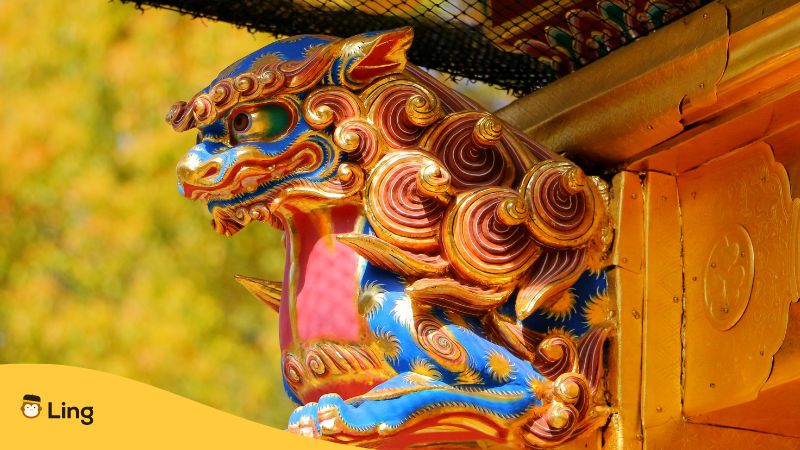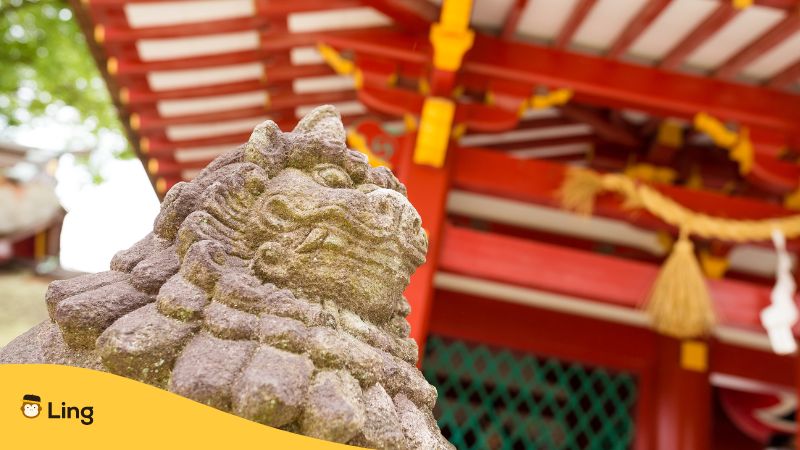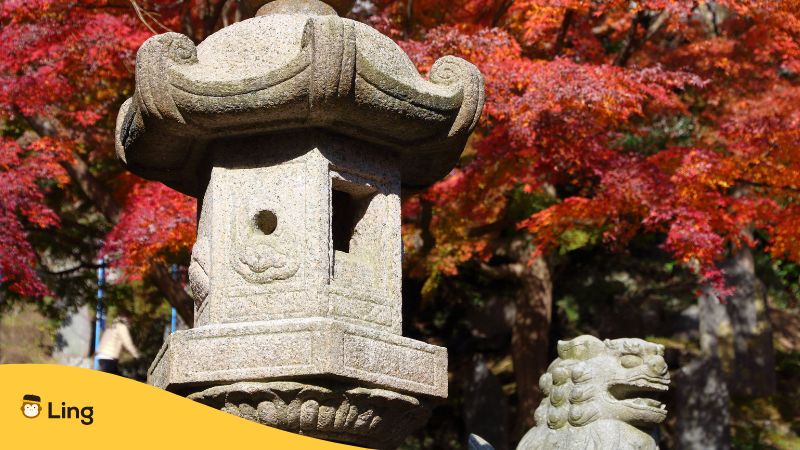If you have an apple pen and a pineapple pen, what do you get? According to fictional Japanese musician Pikotaro (ピコ太郎)’s viral song, a PPAP, which stands for pen pineapple apple pen (ペンパイナッポーアッポーペン), of course! So if you have a lion or ライオン (rion) and a dog or 犬 (inu), what do you get? A Komainu Japanese Lion Dog or 狛犬 (komainu)!
In this article, I’ll be telling you all there is to know about these creatures called Komainu. And while we’re at it, you’ll be learning a Japanese phrase or two related to this topic.

What Is Komainu Japanese Lion Dog?
Now, you may be thinking, it’d be really cool to have a Komainu Japanese lion dog as a pet! Well, I hate to break it to you, but Komainu aren’t real animals. Instead, they’re stone statue pairs of lion-like creatures.
Komainu are called lion dogs because they sure look like ones! They’re even known as a “Korean dog” or “two lions”. Nevertheless, the dog and lion pairs are often considered to be similar and can be used interchangeably, so don’t be afraid to refer to them however you want to.
You’ve definitely seen a Komainu, or more specifically, a pair of them if you’ve visited a Japanese shinto shrine (神社) or Buddhist temples. After all, they traditionally guard the entrance or gate of a shrine. Sometimes, you may even find them in front of or within the main hall or Honden (本殿) of a shrine.
Believed to ward off evil spirits, Komainu serve as symbols of protection for the shrine grounds. And while both statues may look similar, they’re not! If you look closely, one lion has an open mouth or agyō (阿形) which means “a shape”, while the other has a closed mouth or Ungyō (吽形) which means “un shape”. Collectively, they’re known as “A-un”. Cute, isn’t it?

History of Komainu Japanese Lion Dog
Have you ever visited a Chinese temple or a former imperial palace and noticed statues just like Komainu status outdoor? Well, those statues aren’t Komainu, so do not get them blended up! They are Chinese guardian lions, referred to as 石獅 (shíshī) in Chinese.
Now, you is probably thinking, are Komainu and Chinese guardian lions connected? The answer is yes! In fact, you can trace the history of Komainu back to the Tang Dynasty or 唐朝 (tángcháo), a period in historical China.
In Asia, lions have been long believed to have the power to fend off evil. This is why statues resembling them became used to guard important gates and doors. They’ve all been inspired by Asiatic lions, with their depictions introduced thanks to trade from the Middle East or India, where lions are similarly a symbol of strength and might as well.
As the symbol traveled along the Silk Road, however, it changed and adopted its one-of-a-kind look. First appearing in India around the third century BC as a statue erected atop a column by King Ashoka, it later arrived in China, where it was modified to the guardian lion we recognize today. This statue was later exported to places like South Korea and Japan.
Heian Period
Did you know? The Komainu didn’t always stand guard outside shrines and temples. During the Heian Period (794 – 1185) or 平安時代 (Heian jidai), they were used as weights and doorstops to support screens or folding screens at the Imperial Palace. And Komainu weren’t always stone either – they used to come in wooden forms too!
These lion statues weren’t always collectively known as Komainu either. In fact, they used to look more different from each other! The one with an open mouth resembled a lion more, while the one with a closed mouth resembled a dog or “Goguryeo dog” more and sometimes even had a horn on its head!
Over time, however, the lion statues went back to looking more or less identical to each other except for their mouths. These are the modern Komainu statues that we know and love today. Aside from temples, palaces, and nobility residences, they were also sometimes painted inside.
It’s said that the Komainu started to be put outdoors only during the 14th century. And remember how I said they used to come in wooden forms? They’ve since only been made available in stone form, and for good reason – it’s to protect them against exposure to Japan’s rainy weather!

Edo Period
During the Edo Period (1603 – 1868) or 江戸時代 (Edo jidai), people started to put the Komainu at the Sandō (参道) or visiting paths to series. These specific Komainu are known as Sandō Komainu (参道狛犬), which translates to “entrance road Komainu”.
But that’s not all! Komainu which are specifically placed within shrine grounds, temples, or nobility residences have a special name too. They’re known as Jinnai Komainu (陣内狛犬,), which means “Komainu within (the shrine’s) premises.
People started to use animals other than lion or dogs as Komainu during this time too! These new animals include wild boars, tigers, dragons, and foxes or 狐 (kitsuke). Just take the fox statues at Inari shrines or 稲荷神社 (Inari jinja) and Okinawan Shīsā (シーサー) on roofs of houses for example.
Easy Japanese Phrases For Komainu Japanese Lion Dog
Here are some easy Japanese phrases related to the Komainu.
Ready To See Komainu Japanese Lion Dogs?
Now that you know more about the Komainu, be sure to spot them when you visit Japanese shinto shrines or former imperial palaces! And if you’d like to ask a local more questions about them, you should totally download the Ling app and learn some Japanese so that you can do just that.
Aside from simple and essential travel phrases, you’ll learn lots of Japanese grammar and vocabulary too! Whether you just want to get the basics down or want to challenge yourself to more intermediate or advanced levels, it’s totally up to you. So, what are you waiting for? Try the Ling app now.































































